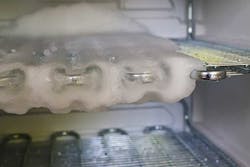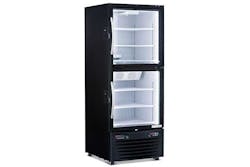Refrigeration is a necessity for many businesses, but it has always come at a high cost, with commercial double door freezers costing as much as $100 or more per month to power, not to mention the labor costs of regularly cleaning and possibly defrosting a fleet. As aging units near the end of their 10-year lifespan, operating them becomes even more expensive, with repairs and rising energy rates adding to the bottom line.
The good news is that recent technological advances have vastly reduced operating costs, making an upgrade the economical choice for a variety of reasons. New refrigerants have made units more efficient and less damaging to the environment with a much lower global warming potential (GWP) than its predecessors. Better engineering has created condensers that do not require cleaning, saving on labor costs and potential downtime. Also available are units with automatic defrost, eliminating the need for manual defrosting.
If your facility needs stable, reliable refrigerated units to store product or materials used in your operations, there’s no better time for an upgrade. Here are five solid reasons to consider modernizing your fleet.
Energy Efficiency Improvements
Freezers are among the top energy-consuming appliances with new efficiency standards being introduced on a regular basis. Environmental standards enacted in 2017 by the Department of Energy reduced energy consumption by 50% and the banning of greenhouse gas emitting refrigerants like R404A and CFCs has brought the industry into a new greener era. R290 is a new refrigerant which has a lower GWP (global warming potential) than the old refrigerants, whilst also allowing for more efficient refrigeration units. Today’s units powered by R290 use less than half the energy consumption of the previous generation, offering an opportunity for tremendous cost savings.
Operating Temperatures
Not all commercial freezers are created the same, and when operating in high ambient temperatures such as a factory without air-conditioning, refrigeration units won’t work as efficiently, and some won’t work at all. If this is the case in your facility, check the manufacturer’s recommended or approved operating conditions before purchasing. Look for units that can perform up to 86° F and 55% relative humidity for the best possible result.
Depending on your operation, another consideration might be pull-down times. That refers to how long it takes for a fully loaded refrigeration unit with product at room temperature to come down to operating temperature. If you are a heavy volume user with high turnover that will be restocking with warm product on a regular basis, this consideration will impact operating costs. Alternatively, if your facility operates in a hot climate, with little to no air conditioning where refrigeration units are operating, it will be extremely important to look for efficient models designed to function in those ambient temperatures.
Climate Mandates
Many companies are adopting environmentally-friendly policies and investing in new equipment to mitigate the causes of climate change. If your company has such a mandate, choosing appliances that actively reduce your carbon footprint is a worthwhile endeavor that can be highlighted to shareholders and customers. In some jurisdictions, incentives to reduce carbon emissions and energy consumption exist, so if a user wants to replace their freezers with a high efficiency model, they might be able to secure a grant or subsidy from their local energy provider.
Maintenance
Should your current units require defrosting you will know this can be time-consuming and costly. Look for units that have auto-defrost functionality to avoid lengthy downtimes and additional labor costs. Many if not most refrigerators and freezers have condensers which need to be cleaned on a regular basis. Instead, look for units with self-cleaning condensers which if exposed to high levels of dust or debris should only require annual visual inspections to ensure they are clean and clear of any blockage. This will depend on how clean the environment is, but it is a feature that can save time, labor, and potential down time all contributing to lower operating costs.
Product integrity and Food Safety
Older chest-style static units don’t have circulated or forced air, to keep an even temperature across all the product stored within. This can have an effect on the quality and shelf life of the product, depending on how long it is stored. If your business requires lengthy storage times for frozen products, ensure freezers have forced air functionality.
The ability to monitor temperatures can be more difficult in an industrial setting, so having fully integrated smart monitors, such as Minus Forty’s Smart Lock, that detects when a high temperature threshold has been reached and automatically locks out the unit, could be essential to operating safely and maintaining product integrity. Considering the cost of malfunctioning equipment in lost sales, repairs, labor and downtime, not to mention the reputational damage that spoiled product can cause, an investment in high quality freezers and refrigerators is critical.
It’s time to take a look at your current refrigeration and cooling equipment, are they serving your business as efficiently as possible? With the technological and environmental advancements made in these products in the last few years, there’s never been a better time to make an upgrade. Investing in advanced refrigeration and cooling equipment can help benefit overall operations and have lasting, positive economical impacts on your business.












